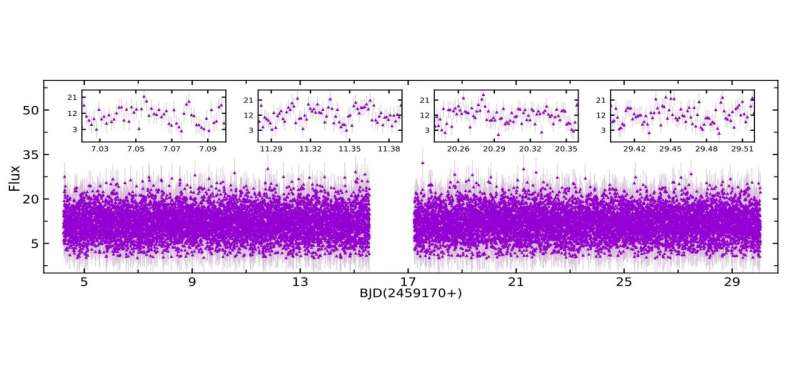October 3, 2022 report
SWIFT J0503.7-2819 is an intermediate polar, research suggests

Tomasz Nowakowski
astronomy writer

Using data from various space telescopes, astronomers have investigated a variable X-ray source known as SWIFT J0503.7-2819. Results of the study suggest that this source is an intermediate polar. The finding was detailed in a paper published September 22 on the arXiv pre-print server.
Cataclysmic variables (CVs) are binary star systems consisting of a white dwarf accreting material from a normal star companion. They irregularly increase in brightness by a large factor, then drop back down to a quiescent state. Polars are a subclass of cataclysmic variables distinguished from other CVs by the presence of a very strong magnetic field in their white dwarfs.
In some CVs, accretion occurs through a truncated accretion disk when the white dwarf is moderately magnetic. These systems are known as intermediate polars (IPs). Observations have shown that in IPs, the magnetic white dwarf spins asynchronously with the orbital period of the system and therefore produces a rapid oscillation with the spin period. Therefore, determining precise spin period and precise oscillation ephemeris could be the key to reveal the IP nature of some CVs.
At a distance of some 2,730 light years, SWIFT J0503.7-2819 (or J0503 for short) is a variable X-ray source first identified in 2015. Further observations of J0503 have found that it has an orbital period of 81.6 minutes and that it may be an IP.
Therefore, in order to verify this hypothesis, a team of astronomers led by Nikita Rawat of the Aryabhatta Research Institute of Observational sciencES (ARIES) in India, performed X-ray observations of J0503 with NASA's Swift and ESA's XMM-Newton telescopes, and optical observations using NASA's Transiting Exoplanet Survey Satellite (TESS). The study was complemented by data from the American Association of Variable Star Observers (AAVSO) catalog.
"We have carried out X-ray and optical timing analyses and X-ray spectral analysis of a probable IP J0503," the researchers wrote in the paper.
The observations found that J0503 has an orbital period of approximately 81.65 minutes. Moreover, a 65.5-minute periodicity was detected and the astronomers attribute it to the spin period of the white dwarf. If this scenario is true, then J0503 would be the first nearly synchronous IP below the period gap.
The astronomers suppose that J0503 is not synchronized due to the fact that the secondary star has a low magnetic moment. Therefore, it is unable to come into synchronism, similar to the nearly synchronous IPs and EX Hya-like systems.
The research found that J0503 might be accreting predominantly via stream-fed accretion. Furthermore, the identified energy-dependent spin pulsations appear to be due to the photoelectric absorption in the accretion flow, which is one of the unique characteristics of the majority of the IPs.
The study also derived fundamental parameters of the white dwarf in J0503. According to the paper, this star has a mass of about 0.54 solar masses, mass accretion rate at a level of 1.44 × 10−10 solar masses per year, and shock height of approximately 27.6 kilometers.
Written for you by our author —this article is the result of careful human work. We rely on readers like you to keep independent science journalism alive. If this reporting matters to you, please consider a (especially monthly). You'll get an ad-free account as a thank-you.
More information: Nikita Rawat, J. C. Pandey, Arti Joshi, Simone Scaringi, Umesh Yadava, SWIFT J0503.7-2819: A nearly synchronous intermediate polar below the period gap? arXiv:2209.11141v1 [astro-ph.HE],
© 2022 Science X Network




















